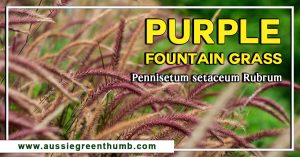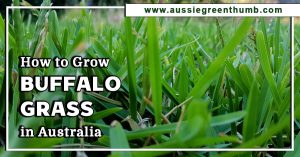If most grasses you've worked with are intolerant of cold and winter, you've probably not worked with Kentucky bluegrass (KBG). You will find that July produces the best growing conditions for Kentucky Bluegrass in Australia.
With good density, colour, and fairly good spreadability, Kentucky Bluegrass responds well to the free-draining and sandy soil of Perth and Western Australia and the cold winters and mild summer heat of Victoria.
So, in this article, we'll talk about Kentucky bluegrasses, how they're planted, cared for, and what their common diseases and pests are.
More...
Getting to Know Kentucky Bluegrass
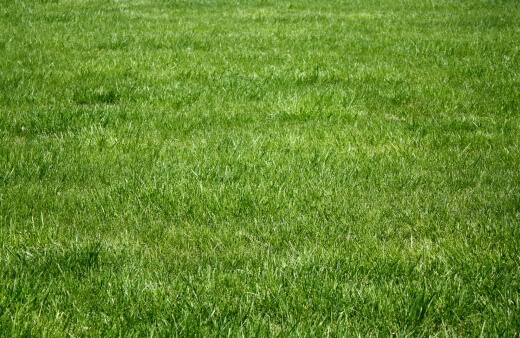
Kentucky bluegrass, commonly called Poa pratensis, meadow poa, meadow grass, common poa, or poa grass, is a perennial type of grass.
Note: Kentucky bluegrass is distinct from annual bluegrass, identified by its botanical name, Poa annua.
In Australia, it is used on sports grounds (tennis, football, rugby, golf greens, etc.) and outdoor playgrounds.
As funny as it sounds, this grass didn't in any way originate from Kentucky, a state in the US. It's not even native to the US or North America. It is native to virtually all of Europe, northern Asia, and the mountains of Algeria and Morocco.
However, it has now been naturalised in North America and, of course, most parts of Australia.
Kentucky Bluegrass Special features
One good thing about this grass is that it grows in most soils, in as much as it is well-drained. It grows well in temperatures ranging from 10 to 18°C.
Like many super hardy turfs, it is quite slow to germinate and grow (about 25 days). Poa pratensis is a perennial grass that can be recognised by looking very closely at the end of its leaves.
It has a characteristic "V" shape, and its very last leaf (the youngest on the stem) is folded. Without mowing, the plant can reach 24 inches.
It is a pale green (bluish green in reality) and matte turf, which remains so in summer and winter. This is very appreciable, especially on golf courses.
Unlike many hardy lawns, Kentucky Bluegrass has the significant advantage of not having a strong colonising tendency. It will not invade or colonise other grasses on your beds and borders as much as fescue or Kikuyu, for example, could.
But Kentucky Bluegrass takes a few years to become dense and bushy, which can be corrected with fertilisation. Kentucky bluegrass thrives in rather dry, even sandy, but well-drained soils. It is, therefore, not suitable for clay soils.


Get Your Free Guide:
Master Growing Australian Natives eBook
A Must Have Complete Guide for Every Australian Garden
Get Your Free Guide:
Master Growing Australian Natives eBook
A Must Have Complete Guide for Every Australian Garden
How to Grow Kentucky Bluegrass
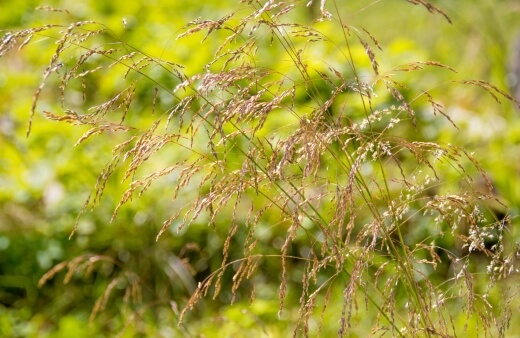
The most delicate step in growing a Kentucky bluegrass lawn is sowing: the land must be adapted, prepared, and weeded, then watered, and maintained with some effort.
But if the growth is well managed, it is a lawn that is here to stay and will not pose any longevity problems.
- Start by completely weeding grassy weeds on the bed before installing the lawn. And don't employ the weedkiller while doing this.
- Run a roller over the surface to be turfed, then a fine rake to break up large clods of earth.
- You may water the earth. This allows loose soil to firm up before sowing. The seedbed should be firm but crumbly.
- Make sure the location is well drained. If your soil is heavy, add sand to it.
- Add 2 kilograms of bluegrass seeds per 100 metre square of land.
- Follow it with well-sifted compost and possibly a suitable fertiliser. You may apply a slow-release fertiliser, an NPK 15/9/15 formula, in October-November.
- After sowing, rake lightly to cover the seeds with a layer of 2 to 5 mm of soil. Rake in one direction only, without back-and-forth movements.
- Once the seeds are covered, a pass of the roller to pack the soil will promote uniform germination.
- Next, you have to water generously within twenty-four hours. Bluegrass seeds require 20 to 30 days to germinate.
Poa pratensis Growing tips
If given enough water when needed, Kentucky Bluegrass will weather summer drought and winter frost unscathed. Bluegrass is best sown in early September. There's too much competition from weeds in the spring.
Where to Plant Kentucky Bluegrass in Australia
Kentucky Bluegrass is best planted outdoors under full sun. Some varieties are not quite tolerant to the shade. Popular planting spots for Kentucky bluegrass in Australia are play areas, sports fields, on the slopes, in sun or shade, or on a green roof.
Kentucky bluegrass can also be used as a ground cover on the edge of watercourses or dykes (its roots will hold the soil). It will need well-drained soil: avoid soils that are too heavy with a high proportion of clay.
It will perform best on sandy loam. If your soil is unsuitable, amend it with a proportion of sand and add special lawn fertiliser or a large quantity of compost.
Because Kentucky Bluegrass germinates and grows slowly, if you must use it to cover completely bare ground, add ryegrass or another fast-growing lawn, and avoid trampling the seeded soil.
If it's a driveway you want to turf with Kentucky bluegrass, opt for a roll or flagstone turf.
How to Care for Kentucky Bluegrass
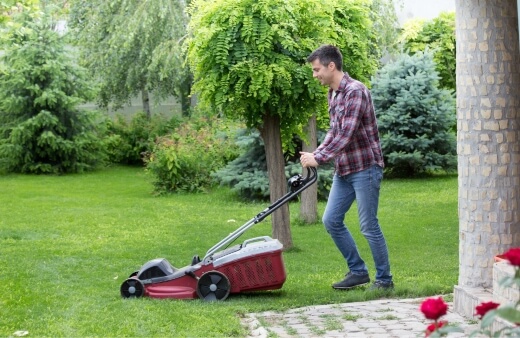
- Young grass should be mowed when it grows over a height of 5 cm from the cut. Subsequent mowing should be fairly frequent, but no more than half of the leaf should be removed at each mowing.
- In summer and during major drought periods, water Kentucky bluegrass whenever the soil is dry to a depth of 5 cm. Let it dry between two waterings. Water preferably in the evening in fine rain (input of 4-5 litres/m2).
- Light fertilisation can be done about four to six weeks after germination.
- Start mowing the lawn in the spring after sowing.
- To correct ground variations caused by winter, level the ground by rolling it three or four times a year.
- Eliminate perennial grasses the first year.
- Cut only a third of the blade of grass (2 to 8 cm) with each pass during mowing
Possible Kentucky Bluegrass Pests and Diseases
When it is overstressed by high or low temperatures, poor soil, or soil dryness, Kentucky Bluegrass can be more prone to weed invasion and disease.
Dollar spot is a common disease of this type of grass, that presents with brown and slimy patches, spots, and a film covering on the individual blades of bluegrass are signs of a concerning issue.
To prevent weeds, you may apply some pre-emergent herbicide first in the fall and spring. However, the post-emergent herbicide will help with weeds already on your lawn. Check out our review to learn more about the types of weed killers and which to apply to your lawn.
Fungicides can be used in preventing and curative applications for Kentucky bluegrass. The most common pests in Kentucky bluegrass varieties are chinch bugs, white grubs, and sod webworms, although these are not often found in healthy lawns.
Turf insecticides can be used to control infestations. However, milky spores are ideal for controlling white grubs.
Kentucky Bluegrass Frequently Asked Questions
Does Kentucky bluegrass spread quickly?
Kentucky bluegrass grows fairly slowly. First, it takes around 20 to 20 days for the seeds to germinate. Fescue, another type of grass found in Australia, takes 5 to 10 days. However, when it finally sprouts, Kentucky Bluegrass spreads faster to fill the lawn.
Check out our guide on the most popular grass types in Australia to help you decide which would best work for you.
Does Kentucky bluegrass like sun or shade?
Kentucky bluegrass grows best in an outdoor spot where it can have sunshine, whether in fall or during the spring months.
Although it can be grown in the shade, in winter, or when the temperatures are cool. It tends to grow slower during the summer months when it's warm.
Is Kentucky bluegrass a good lawn grass?
Kentucky bluegrass is an ideal lawn grass for many garden owners in many parts of the world, from Australia to the US, Asia, Africa, and Europe.
The grass will grow dense, lush, resistant, and durable when given the needed care.
Author Bio: Andrew Hodge

Andrew is a seasoned writer for Dadsmowers.com. Since wrapping up his career as a landscaping manager, Andrew has served in an advisory capacity to a number of lawn care businesses. He currently spends as much time with his grandkids as he can.
Wrapping Up Our Kentucky Bluegrass Growing and Care Guide
As I mentioned, Kentucky bluegrass is ideal for all types of gardens and performs well in free-drained soil. It is used on lawns for public and private landscaping and in fields capable of withstanding sporting activities, including on heavily trampled sports fields and the fairways and tees of golf courses.
Bluegrass can be grown either in the sun or in the shade. It will endure winters with lots of snowfall, and altitude doesn't have much of an impact on its development.
Like all plants, it is not immune to pests, diseases, and competition from other grasses and weeds. But these are all controllable. The maintenance of Kentucky bluegrass in Australia and other places in the world is especially demanding in the first years after sowing.
However, this is still one of the most durable lawns commercially available. Once installed though, you better enjoy it as Kentucky Bluegrass is here to stay.
Published on September 8, 2022 by Maisie Blevins
Last Updated on February 25, 2024



